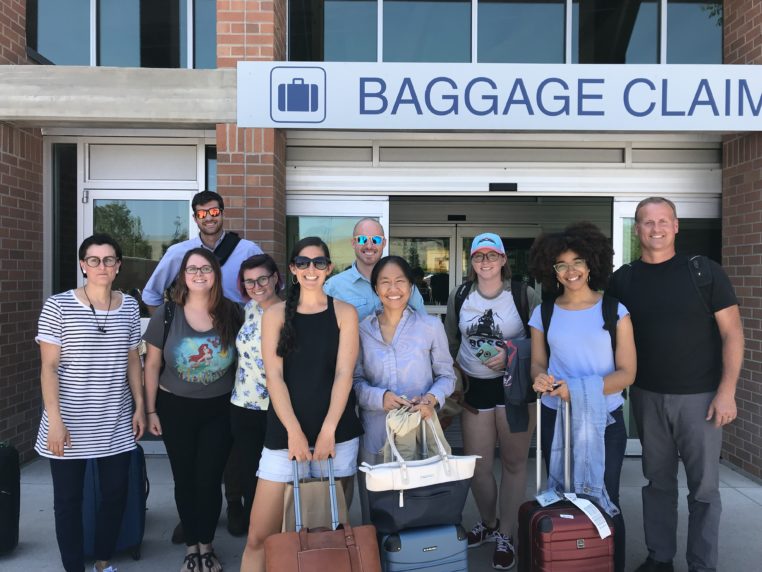In the fall of 2017, Hurricanes Irma and Maria (read about USF’s visit to UVI in June 2018) severely disrupted lives and devastated much of the infrastructure in the U.S. Virgin Islands, among other Caribbean countries. As such, a joint decision among all program partners was made to postpone the launch of Strong Coasts as our friends and colleagues at the University of the Virgin Islands recovered from the disaster’s impact.
More than a year out of these back-to-back tragedies, the Strong Coasts program leaders had the chance to meet in both Missoula, Montana and Washington, DC to learn from other National Science Foundation Research Traineeship (NRT) groups. Below are re-caps of what we did and learned.
From Alex, an anthropology PhD student at USF who attended the conference in Missoula:
The Cross-INFEWS NRT Meeting, “Building a Collaborative Vision for Training INFEWS Leaders” was held July 30-August 1, 2018, at the University of Montana. Organized by the University of Montana, University of Iowa, and University of California, Berkeley and sponsored by NSF, the goal of the conferences was to “realize synergies across programs, co-produce a shared vision to transform graduate training in Innovations at the Nexus of Food, Energy, and Water Systems (INFEWS), and build a community of practice to share knowledge and experiences across institutions.” (http://www.umt.edu/bridges/resources/cross-INFEWS.php) The workshop was not only a great opportunity to meet and learn from other INFEWs researchers but was also a chance to get into the nitty gritty of interdisciplinary work. The organizers set up world café style discussion groups where we rotated from one table to the next to exchange ideas about common problems. They included topics like best practices for framing interdisciplinary work, broadening participation in INFEWs research and communicating complex science to stakeholders and the broader public.
One of the major challenges that consistently came up was how to train interdisciplinary systems thinking. I look forward to seeing how collaborations between disciplines plays out in the future and what insights these projects gain from it. There were also some excellent guest speakers emphasizing approaches for culturally contextualizing our work. Sandra Begay from Sandia National Laboratory spoke of aligning your life and work goals and reducing barriers to isolation, and Ryan Shelby of USAID spoke of cultural relevance incorporated into both US and international research. The Mayor of Missoula even stopped by to give an animated speech about a local project reusing wastewater as fertilizer for poplar tree farming, which he referred to as ‘poop’-lar trees. The students also got a chance to build relationships outside with some river rafting and hiking.
Next, the Annual NRT meeting was held 27-28 September in Washington, DC. Strong Coasts faculty and staff were welcomed with a lecture from Jamie Curtis-Fisk from Dow Chemical Company who spoke about the benefits of preparing graduate students to be flexible, adaptive researchers that can collaborate and contribute beyond Academia, but in industry, government, and other spheres as well. In another group lecture, Dr. Posselt (University of Southern California) and Dr. Miller (Rochester Institute of Technology) discussed their assessment of the graduate student admissions process and their suggestions on a holistic approach to reviewing applications. They underscored the benefits of looking beyond GRE scores, and encouraged departments to develop holistic, systematic rubrics that weigh important factors in student experiences (i.e. previous research or academic experiences). Such an approach enables departments to operationalize a process of selecting cohorts that can represent and facilitate institutional goals (i.e. broadening participation).
Strong Coasts faculty and staff also described a few highlights from the breakout sessions that we hope to adapt into our program:
Student and Community Partner Relationship Building
- A strategy for building student camaraderie and community engagement is to host a weekly luncheon where students, faculty, and local partners would share research updates and progress reports on recent projects. Sharing a meal during this time and prioritizing it as a key to team building was a success for many other NRT programs.
- Our program hopes to adapt this kind of best practice into “Strong Coasts Engaged” where students, faculty, and staff can meet informally to build professional support structures and genuine friendships.
Program Evaluation Techniques
- Various network analysis methods were used to assess students’ knowledge, skills, and social networking within an NRT program. Such an evaluation technique was used to highlight the desire that students had for more interdisciplinary collaborative opportunities, both for class-based academic projects and independent research.
- This approach can be incorporated into Strong Coasts monitoring and evaluation agenda to facilitate rapid programmatic learning and adaptation.


Comments are closed.